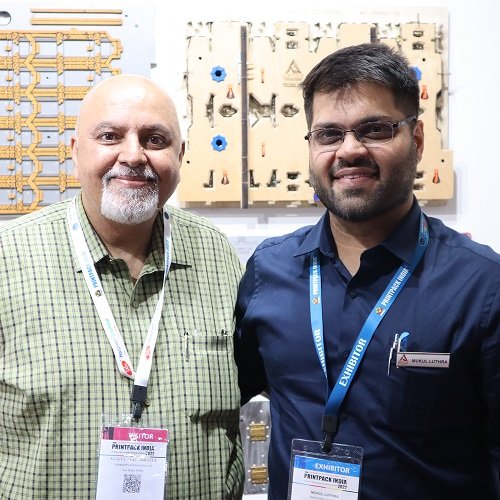
At the recent Printpack India exhibition, New Delhi-based Artize Die Makers showcase its range of dies for the monocarton and corrugated box industry. Artize launched solutions aimed at pain relief for converters and their die-cutting and hot-foil stamping machine operators. Innovations for foil stamping and embossing included its Easy Fix Plate, Hot Foil Stamping Block, and Online Male-Female Embossing Die. The company has developed dies for long-run converting – such as complicated cigarette cartons that were also displayed at the exhibition.
Artize managing director Mukul Luthra noted the company’s regular participation at PrintPack since 2011 and that he was glad to be showcasing its products again after the long Covid-19 pandemic disruption. He said, “I think the show has been organized very well. I would say it’s a world-class show now, with respect to the available facilities, and the organizers have done a great job.
“The newly launched dies save considerable make-ready time and cost and prevent substantial wastage, especially for long-run and repeat converting. They are very handy to use and truly blissful for an operator.” Luthra reported that carton converters were pretty happy to see these products and appreciated the way Artize has developed them. Artize’s innovations to make the operator’s life easier received good feedback and appreciation at its stand at Printpack.
Artize already supplies its dies to many of the leading names in the carton packaging industry including Parksons Packaging, TCPL Packaging, ITC, Meghdoot Packaging, and Velvin Packaging.
Artize’s new plant at Vapi
Artize recently started its new 12,000 square feet plant in Vapi near Mumbai, to be even closer to many of its customers and to further its goal of providing high-quality die-cutting tools and solutions on par with international suppliers and become the most preferable die-cutting solution provider in the industry. The plant has facilities to manufacture both existing and new products. With its larger open and working spaces for die manufacturing, the plant began operations in mid-May and reached 100% production in June.
Luthra adds insight into the Indian die-making market, “If you make a rough estimate, the potential size of the market is about Rs 1,000 crore, of which only Rs 200 crore has been tapped by the laser die manufacturing segment which is what we specialize in. I remember when I came into this industry 12 years ago, this market was estimated at just Rs 25 crore then – it has multiplied by eight times.
“These days converters want fast production where lower labor is involved in producing packaging products, and they are investing in automation for higher efficiency – especially after the Covid-19 pandemic and the ensuing recovery. The Indian consumer product industry and especially the big brands are growing fast and getting bigger and eCommerce is playing a very important role as well. Thus apart from monocartons, the corrugated carton industry is also growing because shipping cartons and printed corrugated boxes have come up in the market.”
While Luthra expects a great comeback for the industry in the coming months, he adds, “I can foresee still another 15 to 20 years of steep upward growth for this industry.”










